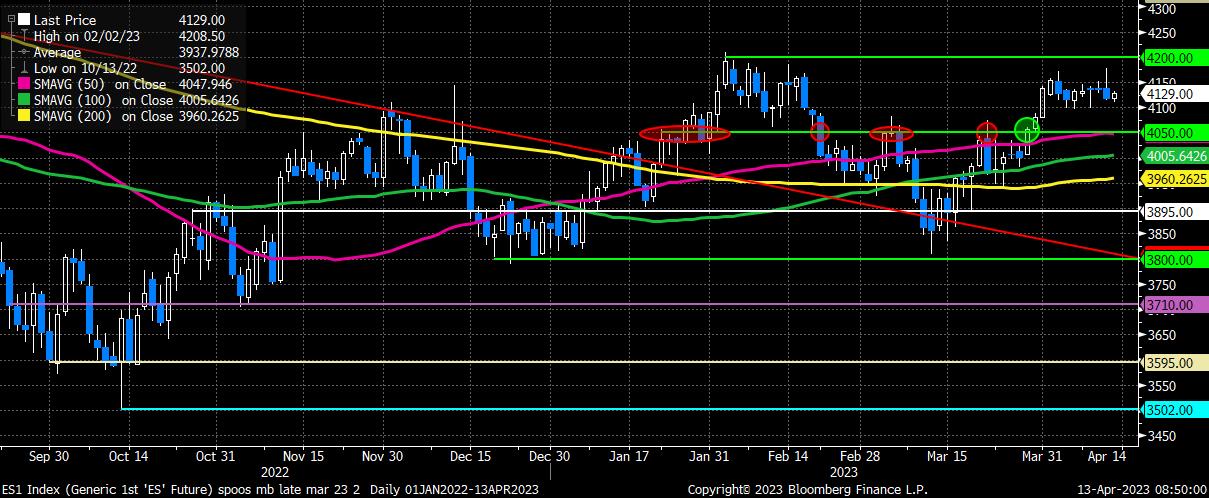- English (UK)
Analysis
Trading The Q1 Earnings Season
For earnings season as a whole, consensus expects a 6.8% decline in earnings compared to Q1 22; if this is borne out, it will mark the largest decline in earnings since the second quarter of 2020, a period which was marred by the pandemic which had just started to rage across the globe. This would all but confirm that the US is in an earnings recession, likely heightening expectations that a full-blown growth recession will follow later this year – something that, incidentally, Fed staff included in their baseline forecast according to minutes from the March FOMC.
_Daily_2023-04-13_08-54-40.jpg)
It must be said, however, that markets are already viewing things through a relatively pessimistic lens. Not only are a plethora of market-based indicators, such as various deeply inverted yield curve spreads, flashing recessionary warning signs, but recent survey data has also softened significantly, especially the leading indicator parts of the recent ISM PMI reports. Furthermore, it’s worth noting that the number of S&P 500 constituents already having issued negative earnings guidance is at its highest level since the third quarter of 2019 – meaning that the bar for an upside surprise is a relatively low one.
In terms of specific sectors, as always, it is the banks that lead us off. Bank earnings are always key for sentiment, giving markets an early gauge of how the upcoming slate of reports is likely to proceed; however, this time around, reports from the financial sector are likely to be of even more importance than usual, given the financial stability risks that have dramatically escalated since the collapse of silicon valley bank. Investors will likely pay close attention to the scale of deposit outflows from regional banks, as well as the potential inflows seen into their larger Wall St counterparts. Commentary from bank CEOs, not only on this issue, but on the broader macroeconomy, will also attract close attention.
Bank stocks have yet to recover the sharp drop seen at the start of March, though it seems unlikely earnings season will be the bullish catalyst needed to recover a significant chunk of that decline.
_Dail_2023-04-13_08-53-23.jpg)
Besides banks, it will, as usual, be the big tech names that have the most significant impact on the market, especially when the tech sector as a whole continues to make up over 25% of the index by market cap. A slew of tech earnings, including those from Apple, Amazon, Alphabet, Meta, and the like will arrive in the last week of April, and the first week of May, with the bulls likely needing some chunky beats in order to wrestle back decisive control of the broader market.
On that note, despite having made a closing break of 4,050, the S&P has failed to move significantly further to the upside, consolidating in a relatively tight range with gains capped by strong resistance at 4,170.

A strong start to reporting season, with banks perhaps surprising to the upside and offering some solid guidance, could push the market towards 4,200. On the other hand, if guidance were to disappoint compared to already-low expectations, the key 4,050 level is likely to come under threat, with a closing break below opening the door to a move towards the 100-day moving average, which lurks just above the psychologically pivotal 4,000 handle.
Related articles
The material provided here has not been prepared in accordance with legal requirements designed to promote the independence of investment research and as such is considered to be a marketing communication. Whilst it is not subject to any prohibition on dealing ahead of the dissemination of investment research we will not seek to take any advantage before providing it to our clients.
Pepperstone doesn’t represent that the material provided here is accurate, current or complete, and therefore shouldn’t be relied upon as such. The information, whether from a third party or not, isn’t to be considered as a recommendation; or an offer to buy or sell; or the solicitation of an offer to buy or sell any security, financial product or instrument; or to participate in any particular trading strategy. It does not take into account readers’ financial situation or investment objectives. We advise any readers of this content to seek their own advice. Without the approval of Pepperstone, reproduction or redistribution of this information isn’t permitted.
